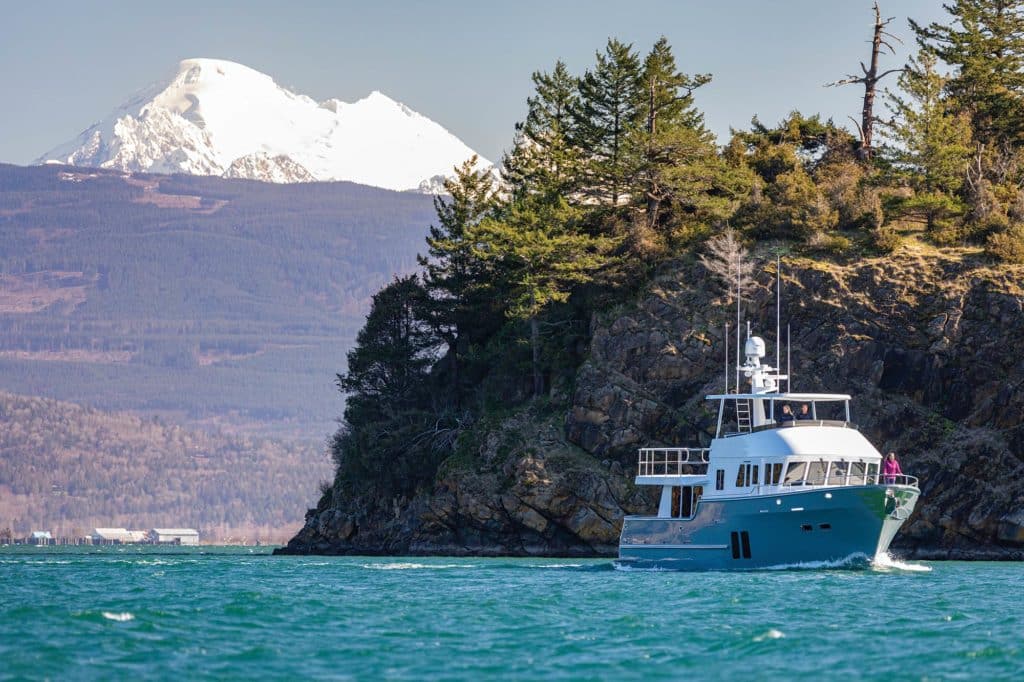
Stepping aboard the Northern Marine 57 Raised Pilothouse feels like stepping onto a small, handsomely appointed ship.
Of course, the yacht’s stainless-steel breastplate, bulbous bow and substantial freeboard offered some foreshadowing as I approached the berth at Cap Sante Marina in Anacortes, Washington. I was a literal stone’s skip from where Northern Marine has built more than 40 yachts since 1995. This was the sixth—and newest—57-footer the company had built since 2002.
Stuart Archer, Northern Marine’s general manager and yacht designer, met me in the cockpit, which is fitted with low-maintenance Flexiteek decking, fiberglass rails and stainless-steel handrails. Archer stands 6 feet, 4 inches and has been plying Pacific Northwest waters since he was a young man. As we moved into the salon, I was happy to see that he designs onboard headroom with taller mariners in mind.
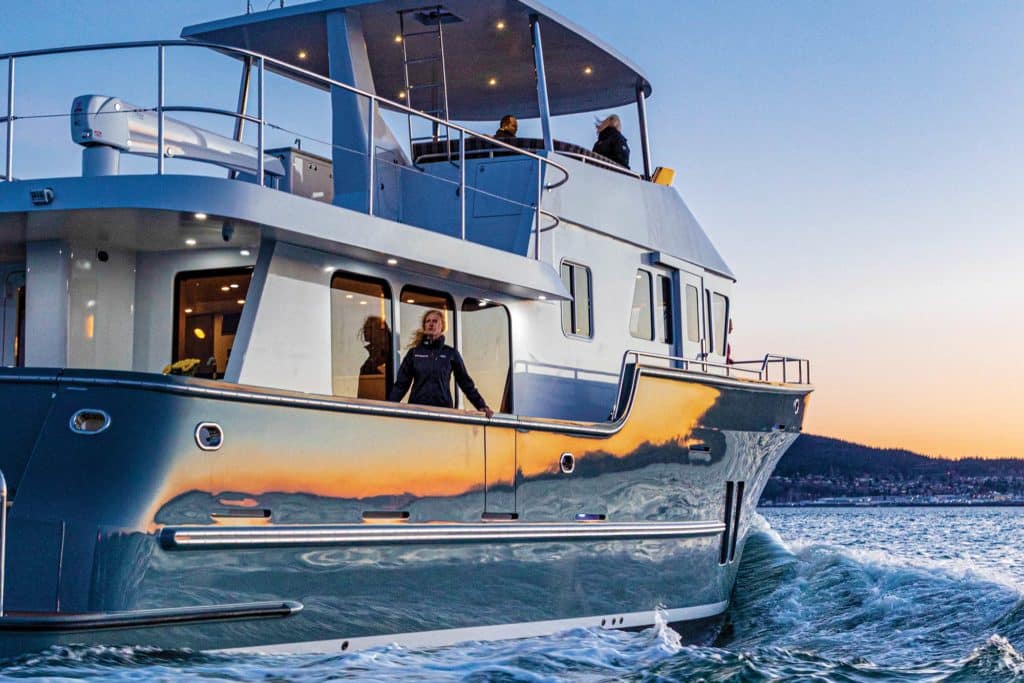
Archer says the 57 would traditionally have walk-around side decks, but this one has a single side deck to starboard, and the superstructure goes full beam to port, increasing the salon’s interior space.
Northern Marine allows owners a high degree of customization. Archer says that anything—from the length overall and layout to the engine, electronics and tankage—can be owner-specified. Some customers, he says, simply point to a sistership; others spec every detail. Build times average two to three years.
While this 57 was built as a high-end spec boat, Northern Marine was founded as a semicustom builder in 1995 by Richard Lemieux, a Delta Marine alumnus who brought 20 years of boatbuilding experience to the chart table. Northern Marine built dozens of yachts, mostly expedition-grade vessels, on Lemieux’s watch before a 2006 ownership change. The Great Recession proved challenging, and ownership continued evolving until some employees licensed the brand and built two vessels. In early 2017, Jay Bernstein, the owner of an earlier Northern Marine 57, acquired a majority stake, but he died mountain biking in 2018. More ownership changes unfurled until Peter Whiting of Seattle Yachts purchased Northern Marine’s assets in 2019.
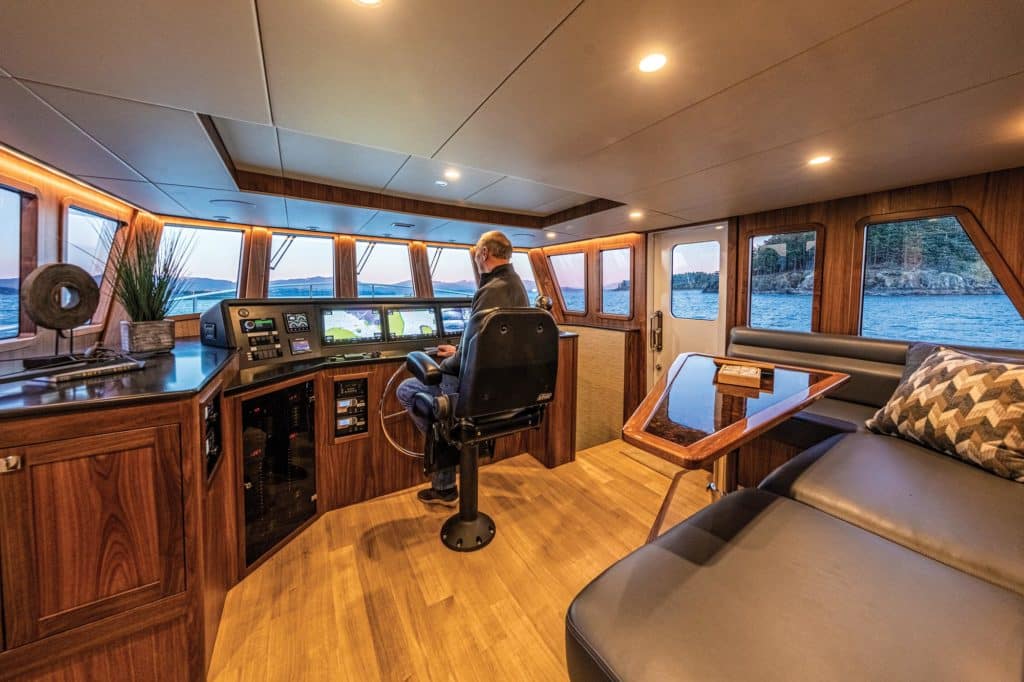
Those assets included the yacht I was aboard, in semi-built condition. Whiting also retained Northern Marine’s core team, whose quality of workmanship and attention to detail were evident everywhere I looked.
Archer says the yacht’s hull and decks (less the tabbing) are built from composite fiberglass and vinylester resin using a vacuum-bag process. Balsa and foam coring is used in the topsides and decks, while everything south of the waterline is solid fiberglass.
All interior woodwork is book-matched walnut, all cabinetry has dovetail joints, and all of the galley’s appliances are tastefully treated with walnut veneers. The headliners are Majilite, some soles are heated, and all lighting is power-friendly LED.
Several strides and two stair risers led us to the galley; two more stairs led to the pilothouse helm with Furuno and Garmin electronics. A day head is abaft and to port of the helm, which is tended from a Stidd seat. A settee abaft and to starboard converts into a berth.
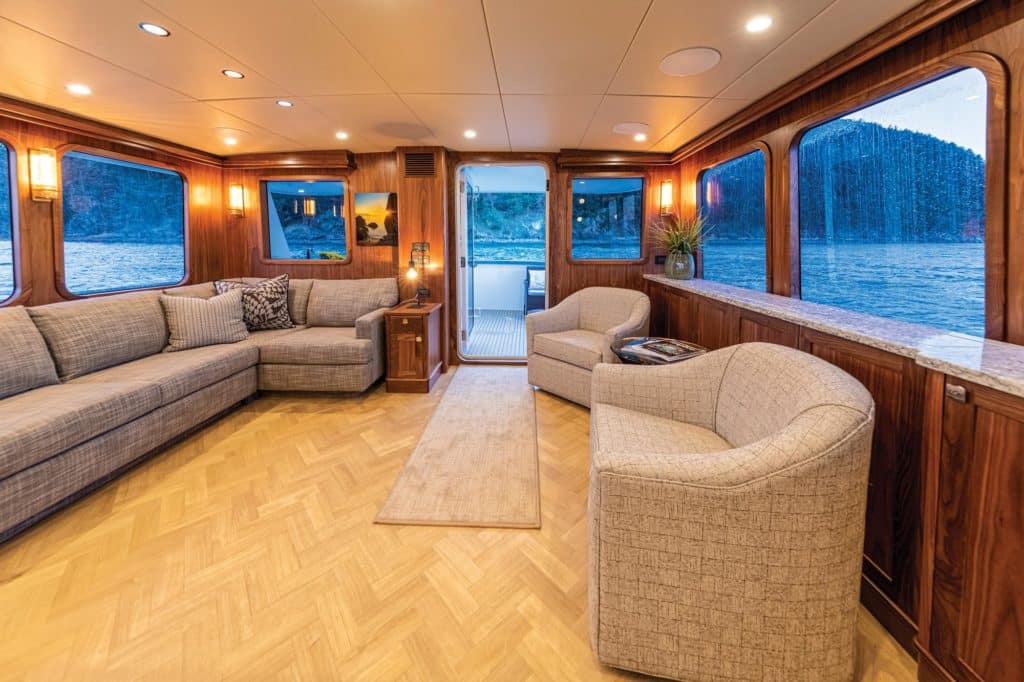
Belowdecks are two staterooms. The full-beam master is a walk-around space with a king-size berth, while the fo’c’sle stateroom has a queen-size berth and a hatch above the headboard for stargazing (and emergency egress). Both staterooms are en suite.
While all the interior spaces feel purposeful, Archer says his designs start with the engine room. There, we had headroom to spare and walking room around the 325 hp John Deere diesel engine (continuous-rated with a below-water exhaust). All wiring is clearly labeled, and operators can change the oil underway. A sea chest allows owner-operators to fish out ingested detritus. The yacht uses hydraulics to power its crane, stabilizer fins and windlass, and it carries a hydraulic get-home drive that can provide 5 to 5.5 knots of speed while sipping fuel.
Topside, via the port stairs, is the flybridge. A 1,500-pound Steelhead Marine crane is aft, with space to accommodate a 17-foot RIB. A fiberglass hardtop shelters the single-seat helm, which has two 16-inch Garmin displays. A mini-fridge, sink, ice maker and grill are just abaft the helm and to port. The grill, I imagine, is invaluable during Alaskan or Patagonian salmon seasons.
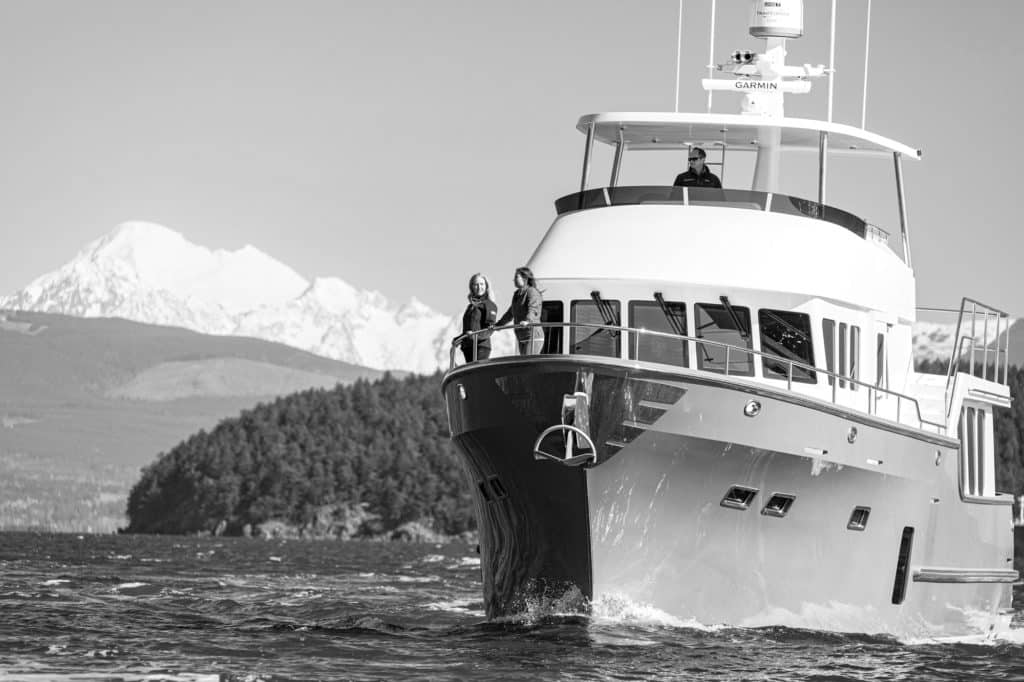
Justin Parkins of Seattle Yachts piloted the 57 out of the slip and into Guemes Channel. A 10- to 15-knot southeasterly breeze was blowing, and the seas were generally flat, at least relative to the yacht’s 130,000- to 135,000-pound displacement. Archer says the 2,600 gallons of diesel yields an approximate maximum range of 5,000 nautical miles at a cruising speed just under 9 knots and 1,550 rpm. The yacht’s top-end speed is 10.6 knots at 2,100 rpm. This 57’s tankage holds 360 gallons of fresh water, 120 gallons of graywater and 170 gallons of blackwater. The watermaker can produce 660 gallons per day.
This yacht’s ride is comfortable, and from the helm, it’s exceptionally quiet too.
“We’ve learned and implemented a few things over the years,” Archer says. “It’s mostly in the fiberglass work.”
When I took the helm, I was most impressed with the yacht’s seakindly manners and maneuverability, given the bulbous bow, full keel and displacement. Later, when I stepped off back at Cap Sante Marina, I couldn’t help but imagine how cool it would be to ply the Northwest Passage aboard this boat.
Full-Length Keel Shoe
The Northern Marine 57 Raised Pilothouse has a full keel with a bulbous bow that’s protected by a full-length, 1½-inch-thick, stainless-steel shoe that extends abaft to the rudder’s trailing edge. The boat also has Kevlar-reinforced bows. Mariners headed for higher latitudes can discuss their itinerary with Northern Marine, which can make customizations accordingly.
Showroom Horsepower
The Northern Marine 57 Raised Pilothouse has a serious engine room. There’s roughly 6 feet, 6 inches of headroom in the air-conditioned main engine room, as well as comfortable crouching space in the lazarette. Networked video cameras enable engine-room monitoring from the helms, and the gleaming 3-inch stainless-steel prop shaft is conspicuous in the bilge.
Interior Aesthetics
This yacht’s interior woodwork is crafted from book-matched walnut. Archer says Northern Marine typically uses sapele or mahogany, and customers can spec any wood they like. The yard usually buys entire trees, a practice that helps hone the book-matching acumen. All cabinetry has dovetail joints, solid drawer fronts and thick veneers.
Take the next step: northernmarine.com









